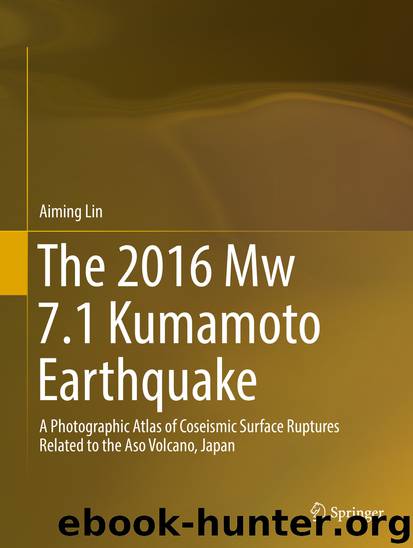The 2016 Mw 7.1 Kumamoto Earthquake by Aiming Lin

Author:Aiming Lin
Language: eng
Format: epub
Publisher: Springer Singapore, Singapore
3.3.3 Northeast Segment
In contrast to the central and southwest segments, the northeast segment shows a relatively complicated distribution of surface rupture patterns in a wide area around the western and southern sides of Aso caldera. Based on the distribution and deformation features, this segment can be subdivided into five branch rupture zones (called Zone-N1 to Zone-N5), each with a different orientation (Fig. 3). Zone-N1, striking N40−60°E, is mainly composed of normal faults and extensional cracks that form graben structures (see below for details), extending ~10 km along the northwestern edge of Aso caldera (Fig. 3). Zone-N2 occurs along the southwestern edge of Aso caldera, striking N−S, and oblique to Zone-N1. Zone-N3 is the northeastern extension of Zone-C2 of the NE–central segment, which crosscuts the southwestern rim of Aso caldera and Komezuka cone (inside the caldera) with a conjugate geometric pattern of ruptures striking N50−60°E and N50−70°W, respectively (Fig. 3). Surface ruptures are also found in the area around the crater and foot of Komezuka cone in a doughnut-shaped pattern (see below for details). The ruptures of Zone-N1 and Zone-N3 terminated at the northeastern side, near the northern edge of the caldera. Zone-N4 shows more irregular geometric pattern than Zone-N1, which is locally bended and branched. This zone is subparallel to the general trend of Zone-N3, 0.5−3 km east of Zone-N3; crosscuts the southwest–northwestern side of Aso caldera, bounded by Kishima and Nakadake cones in the east and Komezuka cone in the west; and terminates at the northeastern edge of the caldera. Rupture in this zone was inferred to terminate near Aso Shrine in the northeast, which was completely destroyed by the earthquake. Zone-N5 lies on the southern slope of Nakadake cone along the southern edge of the caldera (Fig. 3). Coseismic surface ruptures were observed along a linear scarp striking N70−80°W and dipping south, which developed on alluvial fans formed from southward-flowing drainages in the northern side of the northwestward flowing Shirakawa River.
Download
This site does not store any files on its server. We only index and link to content provided by other sites. Please contact the content providers to delete copyright contents if any and email us, we'll remove relevant links or contents immediately.
Man-made Catastrophes and Risk Information Concealment by Dmitry Chernov & Didier Sornette(4794)
The Revenge of Geography: What the Map Tells Us About Coming Conflicts and the Battle Against Fate by Kaplan Robert D(3620)
Zero Waste Home by Bea Johnson(3313)
COSMOS by Carl Sagan(2976)
In a Sunburned Country by Bill Bryson(2971)
Good by S. Walden(2938)
The Fate of Rome: Climate, Disease, and the End of an Empire (The Princeton History of the Ancient World) by Kyle Harper(2459)
Camino Island by John Grisham(2410)
A Wilder Time by William E. Glassley(2380)
Organic Mushroom Farming and Mycoremediation by Tradd Cotter(2324)
Human Dynamics Research in Smart and Connected Communities by Shih-Lung Shaw & Daniel Sui(2195)
The Ogre by Doug Scott(2140)
Energy Myths and Realities by Vaclav Smil(2083)
The Traveler's Gift by Andy Andrews(2031)
Inside the Middle East by Avi Melamed(1957)
Birds of New Guinea by Pratt Thane K.; Beehler Bruce M.; Anderton John C(1927)
Ultimate Navigation Manual by Lyle Brotherton(1783)
A History of Warfare by John Keegan(1739)
And the Band Played On by Randy Shilts(1640)
